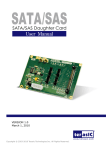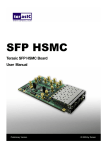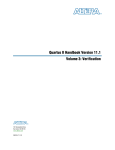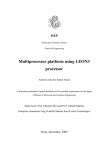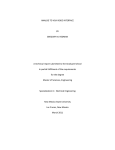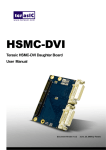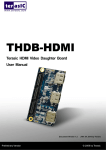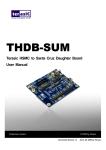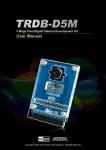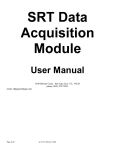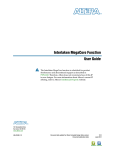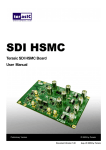Download XTS UserManual
Transcript
Terasic THDB-H2G XTS Terasic XTS Daughter Card User Manual Document Version 1.0 DEC. 29, 2009 by Terasic Introduction Page Index INTRODUCTION ..............................................................................................................................................................................1 1-1 1.1 FEATURES .............................................................................................................................................................................1 1.2 ABOUT THE KIT............................................................................................................................................................................2 1-2 1.2 GETTING HELP ......................................................................................................................................................................2 ARCHITECTURE .............................................................................................................................................................................3 1-3 2.1 LAYOUT AND COMPONETS ....................................................................................................................................................3 1-4 2.2 BLOCK DIAGRAM ...................................................................................................................................................................5 BOARD COMPONENTS.................................................................................................................................................................6 1-5 3.1 HSMC EXPANSION CONNECTOR .........................................................................................................................................6 DEMONSTRATION........................................................................................................................................................................13 4.1 INTRODUCTION...........................................................................................................................................................................13 4.2 SYSTEM REQUIREMENTS ..........................................................................................................................................................14 4.3 SETUP THE DEMONSTRATION ....................................................................................................................................................14 4.4 DEMO OPERATION .....................................................................................................................................................................16 APPENDIX ......................................................................................................................................................................................17 5.1 REVISION HISTORY ....................................................................................................................................................................17 5.2 ALWAYS VISIT XTS W EBPAGE FOR NEW MAIN BOARD.............................................................................................................17 ii Introduction 1 Introduction The XTS daughter card is designed to convert FPGA transceiver channels to SMA connectors through a High-Speed Mezzanine Connector (HSMC) interface. It is intended to allow users to evaluate the performance of transceiver-based host boards with HMSC interface specifically Stratix IV GX, Stratix II GX, Arria II GX, and Cyclone IV GX with integrated transceivers. Through the SMA connectors, the FPGA transceiver signals can be easily connected to measurement instruments as well as allowing gigabit data rate communication between multiple FPGA boards. The XTS daughter card is the ideal platform to allow users to prototype and test their high-speed interfaces quickly and easily in support of transceiver performance for jitter, protocol compliance, and equalization. 1.1 Features 1-1 Figure 1.1 shows the photo of the XTS card. The important functions of the XTS card are listed below: • Convert transceiver channels to SMA connectors through HSMC interface • Support 4 transceiver channels • SMA connectors for PLL input and output differential clock • Applicable for large volume applications that require high-speed (Gigabit) data transfer Figure 1.1. The picture of the XTS card 1 Introduction 1.2 About the KIT This section describes the package content • XTS Card x 1 • System CD-ROM x 1 The CD contains technical documents of the XTS card Figure 1.2 XTS Card Package 1.2 Getting Help 1-2 Here are some places to get help if you encounter any problem: Email to [email protected] Taiwan & China: +886-3-550-8800 Korea : +82-2-512-7661 Japan: +81-428-77-7000 2 Architecture 2 Architecture This chapter describes the architecture of the XTS card including block diagram and components. 2.1 Layout and Componets 1-3 The picture of the XTS is shown in Figure 2.1 and Figure 2.2. It depicts the layout of the board and indicates the locations of the connectors and key components. TX SMAs RX SMAs Test-Point Area Test-Point Area SMA Output CLK SMA Input CLK Figure 2.1 The XTS Card PCB and component diagram 3 Architecture Figure 2.2 The XTS card back side – HSMC connector view The following components are provided on the XTS card : • HSMC expansion connector (J8) • TX SMAs (J9,J11,J13,J15,J17,J19,J21,J23) • RX SMAs (J10,J12,J14,J16,J18,J20,J22,J24) • SMA Output CLK (J25,J27) • SMA Input CLK (J26,J28) 4 Architecture 2.2 Block Diagram 1-4 Figure 2.3 shows the block diagram of the XTS card. HSMC Connector Channel 1 Channel 2 4 Transceivers 4 Channel 3 Channel 4 Transceivers connected to SMA connectors Clock In/Out Clock Inputs/Outputs to SMA Connectors Figure 2.3. The block diagram of the XTS Card 5 Board Components 3 Board Components This section will describe the detailed information of the components, connector interfaces, and the pin mappings on the XTS card. 3.1 HSMC Expansion Connector 1-5 This section describes the HSMC connector on the XTS card The XTS card contains an Altera standard HSMC connector. All the other interfaces on the XTS card are connected to the HSMC connector. Figure 3.1 shows the pin-outs of the HSMC connector and Table 3.1 lists the description of each signals corresponding to the HSMC connector. 6 Board Components Figure 3.1 The pin-outs of the HSMC connector. 7 Board Components Table 3.1 below lists the HSMC signal direction and description Pin Name Direction Description 1 N.C. N/A Not Connect 2 N.C. N/A Not Connect 3 N.C. N/A Not Connect 4 N.C. N/A Not Connect 5 N.C. N/A Not Connect 6 N.C. N/A Not Connect 7 N.C. N/A Not Connect 8 N.C. N/A Not Connect 9 N.C. N/A Not Connect 10 N.C. N/A Not Connect 11 N.C. N/A Not Connect 12 N.C. N/A Not Connect 13 N.C. N/A Not Connect 14 N.C. N/A Not Connect 15 N.C. N/A Not Connect 16 N.C. N/A Not Connect 17 HSMC_TX_P3 Output SMA Transceiver Output 18 HSMC_RX_P3 Input SMA Transceiver Input 19 HSMC_TX_N3 Output SMA Transceiver Output 20 HSMC_RX_N3 Input SMA Transceiver Input 21 HSMC_TX_P2 Output SMA Transceiver Output 22 HSMC_RX_P2 Input SMA Transceiver Input 23 HSMC_TX_N2 Output SMA Transceiver Output 24 HSMC_RX_N2 Input SMA Transceiver Input 25 HSMC_TX_P1 Output SMA Transceiver Output 26 HSMC_RX_P1 Input SMA Transceiver Input 27 HSMC_TX_N1 Output SMA Transceiver Output 28 HSMC_RX_N1 Input SMA Transceiver Input 29 HSMC_TX_P0 Output SMA Transceiver Output 30 HSMC_RX_P0 Input SMA Transceiver Input 31 HSMC_TX_N0 Output SMA Transceiver Output 32 HSMC_RX_N0 Input SMA Transceiver Input 33 N.C. N/A Not Connect 34 N.C. N/A Not Connect 35 HSMC_TCK Inout JTAG Numbers 8 Board Components 36 HSMC_TMS Inout JTAG 37 HSMC_TDO Inout JTAG 38 HSMC_TDI Inout JTAG 39 HSMC_CLKOUT0 N/A CLKOUT0 Test-Point 40 HSMC_CLKIN0 N/A CLKIN0 Test-Point 41 N.C. N/A Not Connect 42 N.C. N/A Not Connect 43 N.C. N/A Not Connect 44 N.C. N/A Not Connect 45 3V3 Power Power 3.3V 46 12V Power Power 12V 47 N.C. N/A Not Connect 48 N.C. N/A Not Connect 49 N.C. N/A Not Connect 50 N.C. N/A Not Connect 51 3V3 Power Power 3.3V 52 12V Power Power 12V 53 N.C. N/A Not Connect 54 N.C. N/A Not Connect 55 N.C. N/A Not Connect 56 N.C. N/A Not Connect 57 3V3 Power Power 3.3V 58 12V Power Power 12V 59 N.C. N/A Not Connect 60 N.C. N/A Not Connect 61 N.C. N/A Not Connect 62 N.C. N/A Not Connect 63 3V3 Power Power 3.3V 64 12V Power Power 12V 65 N.C. N/A Not Connect 66 N.C. N/A Not Connect 67 N.C. N/A Not Connect 68 N.C. N/A Not Connect 69 3V3 Power Power 3.3V 70 12V Power Power 12V 71 N.C. N/A Not Connect 72 N.C. N/A Not Connect 73 N.C. N/A Not Connect 9 Board Components 74 N.C. N/A Not Connect 75 3V3 Power Power 3.3V 76 12V Power Power 12V 77 N.C. N/A Not Connect 78 N.C. N/A Not Connect 79 N.C. N/A Not Connect 80 N.C. N/A Not Connect 81 3V3 Power Power 3.3V 82 12V Power Power 12V 83 N.C. N/A Not Connect 84 N.C. N/A Not Connect 85 N.C. N/A Not Connect 86 N.C. N/A Not Connect 87 3V3 Power Power 3.3V 88 12V Power Power 12V 89 N.C. N/A Not Connect 90 N.C. N/A Not Connect 91 N.C. N/A Not Connect 92 N.C. N/A Not Connect 93 3V3 Power Power 3.3V 94 12V Power Power 12V 95 HSMC_CLKOUT_P1 N/A Differential CLKOUT Test-Point 96 HSMC_CLKIN_P1. N/A Differential CLKIN Test-Point 97 HSMC_CLKOUT_N1 N/A Differential CLKOUT Test-Point 98 HSMC_CLKIN_N1 N/A Differential CLKIN Test-Point 99 3V3 Power Power 3.3V 100 12V Power Power 12V 101 N.C. N/A Not Connect 102 N.C. N/A Not Connect 103 N.C. N/A Not Connect 104 N.C. N/A Not Connect 105 3V3 Power Power 3.3V 106 12V Power Power 12V 107 N.C. N/A Not Connect 108 N.C. N/A Not Connect 109 N.C. N/A Not Connect 110 N.C. N/A Not Connect 111 3V3 Power Power 3.3V 10 Board Components 112 12V Power Power 12V 113 N.C. N/A Not Connect 114 N.C. N/A Not Connect 115 N.C. N/A Not Connect 116 N.C. N/A Not Connect 117 3V3 Power Power 3.3V 118 12V Power Power 12V 119 N.C. N/A Not Connect 120 N.C. N/A Not Connect 121 N.C. N/A Not Connect 122 N.C. N/A Not Connect 123 3V3 Power Power 3.3V 124 12V Power Power 12V 125 N.C. N/A Not Connect 126 N.C. N/A Not Connect 127 N.C. N/A Not Connect 128 N.C. N/A Not Connect 129 3V3 Power Power 3.3V 130 12V Power Power 12V 131 N.C. N/A Not Connect 132 N.C. N/A Not Connect 133 N.C. N/A Not Connect 134 N.C. N/A Not Connect 135 3V3 Power Power 3.3V 136 12V Power Power 12V 137 N.C. N/A Not Connect 138 N.C. N/A Not Connect 139 N.C. N/A Not Connect 140 N.C. N/A Not Connect 141 3V3 Power Power 3.3V 142 12V Power Power 12V 143 N.C. N/A Not Connect 144 N.C. N/A Not Connect 145 N.C. N/A Not Connect 146 N.C. N/A Not Connect 147 3V3 Power Power 3.3V 148 12V Power Power 12V 149 N.C. N/A Not Connect 11 Board Components 150 N.C. N/A Not Connect 151 N.C. N/A Not Connect 152 N.C. N/A Not Connect 153 3V3 Power Power 3.3V 154 12V Power Power 12V 155 HSMC_CLKOUT_P2 Output SMA differential Output CLK 156 HSMC_CLKIN_P2 Input SMA differential Input CLK 157 HSMC_CLKOUT_N2 Output SMA differential Output CLK 158 HSMC_CLKIN_N2 Input SMA differential Input CLK 159 3V3 Power Power 3.3V 160 HSMC_PSNTn Power Power Ground 12 Demonstration 4 Demonstration This chapter illustrates the reference design for the XTS HSMC card 4.1 Introduction This section describes the functionality of the demonstration briefly. The demonstration illustrates a loopback test for transceiver channels using the XTS daughter card and the Stratix IV GX FPGA Development board. Figure 4.1 depicts the basic block diagram for this demonstration. The demonstration is intended for users to provide a basic introduction to the XTS daughter card with the procedures to control different hardware and software settings. FPGA Host Board XTS Board HSMC Connector TX Transceiver Channels TX_Pattern ALTGX (Altera Transceiver Megafunction) RX_Verify TX SMA Connector SMA Cable RX Transceiver Channels RX SMA Connector Figure 4.1 Block diagram of the loopback test function 13 Demonstration 4.2 System Requirements The following items are required for the XTS loopback demonstration. • XTS x 1 • Stratix IV GX FPGA Development Board x 1 • SMA Cable x 8 4.3 Setup the Demonstration Figure 4.2, 4.3, 4.4 and 4.5 shows how to setup hardware for the XTS demonstration. i. Connect SMA Cable to J21 and J23 as shown in Figure 4.2 to short the positive signal of the transceiver channel 0 (HSMC-TX0p). Figure 4.2 Short J21 and J22 via SMA Cable ii. Connect SMA Cable to J22 and J24 as shown in Figure 4.3 to short the negative signal of the transceiver channel 0 (HSMC-TX0n). 14 Demonstration Figure 4.3 Short J23 and J24 via SMA Cable iii. Repeat steps i and ii to short the other transceiver channels as shown in Figure 4.4. Figure 4.4 Short all the transceiver channels iv. Connect the XTS card to Stratix IV GX FPGA Development Board (See Figure 4.5). 15 Demonstration Figure 4.5 Transceiver loopback test setup Note: The XTS card must be connected to HSMC Slot “A” of the Stratix IV GX FPGA Development Board for this demonstration 4.4 Demo Operation This section describes the procedures of running the demonstration FPGA Configuration Demonstration Setup, File Locations, and Instructions Transceiver Loopback Test Demo: • Project directory: xts_loopback_test_s4gfp • Bit Stream used: xts_loopback_test_s4gfp.sof • Stratix IV GX FPGA Development Kit Setup • Set SW4 switches 1, 2, 4 in the “up” position and switches 3, 5, 6, 8 in the “down” position Set the rotary switch (SW2) to the 0 position Power on the Stratix IV GX FPGA Development Board and download the SOF file (xts_loopback_test_s4gfp.sof) • LED0~LED3 shows the test results for transceiver channels 0~3, respectively. If the LED is blinking, it 16 Appendix indicates the test has passed. • Remove one of the SMA cable from one of the connector so that the loopback will fail. indicated on the Stratix IV GX FPGA Dev Kit when the LED turns ON • To reset the board test system, press and release the PB0 reset button on the host board • Press and release PB1 can insert error pattern and create failure condition. 5 Appendix 5.1 Revision History Date Change Log DEC 29, 2009 Initial Version JAN 12, 2010 Added demonstration chapter 5.2 Always Visit XTS Webpage for New Main board We will be continuing providing interesting examples and labs on our XTS webpage. Please visit www.altera.com or xts.terasic.com for more information. 17 A Failure is



















